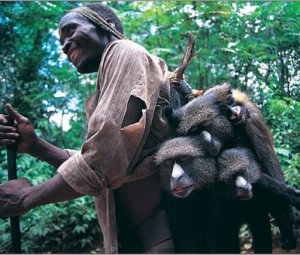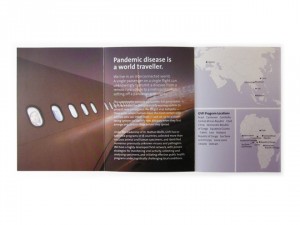By Autumn Albers
Building upon traditional public health approaches, Global Viral Forecasting (GVF) presents a fresh perspective in addressing the global threat of infectious disease. Founded by Stanford alumnus and visiting professor Dr. Nathan Wolfe in 2000, GVF is an organization dedicated to the development of a global system to predict and prevent pandemics for the promotion of greater human welfare. To gain insight into GVF’s approach and current projects, SJPH interviewed Stephanie Nevins, a research director for GVF’s Innovative Research Team.
 Nevins believes that GVF’s focus on disease prediction and prevention sets it apart from traditional public health efforts. “Global disease control has really been focused almost exclusively on responding to epidemics rather than being able to predict them or forecast them in any way. Our company really strives to prevent novel and emerging pandemics.” GVF’s unique approach makes this possible. In their multi-faceted approach, GVF research teams investigate the methods by which diseases spread at the biological level, behavioral level, and social and technological level.
Nevins believes that GVF’s focus on disease prediction and prevention sets it apart from traditional public health efforts. “Global disease control has really been focused almost exclusively on responding to epidemics rather than being able to predict them or forecast them in any way. Our company really strives to prevent novel and emerging pandemics.” GVF’s unique approach makes this possible. In their multi-faceted approach, GVF research teams investigate the methods by which diseases spread at the biological level, behavioral level, and social and technological level.
Biological research led to the founding of Global Viral Forecasting. Dr. Nathan Wolfe’s landmark discovery that HTLV-3 and HTLV-4, two viruses belonging to the same family a s HIV, had “spilled over” from primates to hunters in Cameroon, Africa, formed the basis for GVF as an organization that would continue the viral discovery research that Dr. Wolfe had initiated.
Currently GVF has projects focused on viral discovery and viral monitoring in over twenty countries, many of which are infrequently studied by other public health organizations. GVF’s biological research teams collect blood samples from high-risk wildlife and human populations, and test them in the laboratory for potentially dangerous viruses . Nevins explains, “the way that our fieldwork is structured is that we have a set of hunters and wet meat markets that we monitor. We introduce volunteer hunters [to] become part of our global monitoring network by, on their own, collecting small blood samples of the animals that they are killing and butchering. They collect these samples on filter paper, store them for collection by a field team,who then travels back to those sites regularly to collect more samples and to inform those hunters, their families, and others in their village what has been identified in the samples that have been analyzed.”
GVF focuses on bushmeat hunters and wet markets because they include two populations that are at high risk for spillover events between animals and humans. Bushmeat hunters are often in direct contact with the blood and fluids of animals during butchering, putting them at high risk for parenteral viruses that may enter through cuts and punctured skin. , Similarly, wetmarkets selling live animals also have butchering events, exposing both vendors and consumers to potentially dangerous animal fluids. In addition, wetmarkets pose another risk: by containing a variety of animals within a small area, they serve as a hotspot for cross-species contamination of disease.
Because human behaviors like bushmeat hunting and partcipating in wet market activity are linked to disease risk, behavioral research is also key to GVF’s pandemic surveillance. GVF’s behavioral research team focuses on the anthropology associated with risky behaviors. According to Nevins, the team looks at the “degree of interaction of bushmeat hunters with wild animal carcasses and measur[es] the specific risk points and degree of risk associated with different species [and] different hunting techniques.” They use the information to recommend behavioral changes that will mitigate disease risk and improve health in these communities.
 However, making behavioral recommendations in these communities is not always easy. Nevins claims that one of the biggest challenges with behavioral research is finding the balance between research and cultural sensitivity. For example, while it seems logical to encourage people not to eat bushmeat, this issue is much more complex. Bushmeat hunting is a cultural and traditional practice that is often used to supplement household nutrition, especially in places where there is no available supply of domestic meat. As a result, while researchers see the hunting and butchering of wildlife as a serious health threat, they must be sensitive to the cultural practices of the communities, particularly when the practices reflect important dietary needs. Nevins explains, “The issue requires thinking critically not only about the biological implications of the behavior, but also the cultural reasons for which the behavior exists”. She emphasizes that cultural sensitivity is really important to keep in mind when doing research in another country and another culture.
However, making behavioral recommendations in these communities is not always easy. Nevins claims that one of the biggest challenges with behavioral research is finding the balance between research and cultural sensitivity. For example, while it seems logical to encourage people not to eat bushmeat, this issue is much more complex. Bushmeat hunting is a cultural and traditional practice that is often used to supplement household nutrition, especially in places where there is no available supply of domestic meat. As a result, while researchers see the hunting and butchering of wildlife as a serious health threat, they must be sensitive to the cultural practices of the communities, particularly when the practices reflect important dietary needs. Nevins explains, “The issue requires thinking critically not only about the biological implications of the behavior, but also the cultural reasons for which the behavior exists”. She emphasizes that cultural sensitivity is really important to keep in mind when doing research in another country and another culture.
GVF’s final main area of research, the area that has been increasing in activity most recently, is GVF’s involvement in social and technological sectors that are not directly affiliated with public health. Since its founding in 2000, GVF has worked closely with Google.org and the Skoll Foundation. It has investigated how online sources of information can be used as markers for disease spread and has “partnered with various organizations and start-ups in Silicon Valley, exploring the ways to use social networking, vocal phone records, and text message technology to track disease spread and improve overall health.” Nevins notes that text messaging (SMS) is particularly important in monitoring disease globally, as text message technology is widely used and readily available to people all over the world.
One of GVF’s most recent projects in the technological sector is based on a partnership with Harvard University and Facebook. GVF will be “investigating the ability of Facebook data to provide early warning signs of contagious disease spread.” They will probably initiate this research on a college campus in the fall.
The ultimate goal of GVF is two-fold, according to Nevins. The first goal is to give back to the populations in which GVF performs investigative research. GVF aims to “educate populations, especially the ones that [they are] actually researching—bushmeat hunters, wetmarket goers—about emerging disease threats”, says Nevins. Because bushmeat hunters and wetmarket attendees might be at higher risk for acquiring or spreading these diseases, GVF educates them on how they might alter their behavior to mitigate those risks. The second goal is to increase the world’s knowledge of pathogen diversity by collecting samples, building knowledge and sharing its investigative research in collaboration with other public health groups, including the World Health Organization (WHO) and the Centers for Disease Control (CDC). “Our research is really trying to push forward one whole comprehensive system that allows researchers, academic institutions, [and] large government organizations to be able to use all the information as a whole to understand the diversity of disease and other viruses that are out there.” Through their unique approaches to public health research that utilize the biological, behavioral, and technological fields, GVF aims to increase the ability of public health researchers to predict, understand and respond to disease emergence, outbreak, and spread worldwide.
[fbshare type=”button”] [twitter style=”horizontal” float=”left”]
